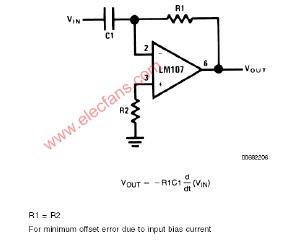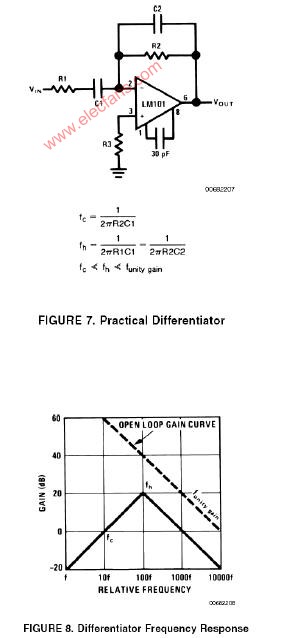

微分器:Differentiator
运算放大器电路
描述
微分器:Differentiator
The differentiator is shown in Figure 6 and, as the name implies, is used to perform the mathematical operation of differentiation. The form shown is not the practical form, it is a true differentiator and is extremely susceptible to high frequency noise since AC gain increases at the rate of 6 dB per octave. In addition, the feedback network of the differentiator, R1C1, is an RC low pass filter which contributes 90° phase shift to the loop and may cause stability problems even with an amplifier which is compensated for unity gain.

A practical differentiator is shown in Figure 7. Here both the stability and noise problems are corrected by addition of two additional components, R1 and C2. R2 and C2 form a 6 dB per octave high frequency roll-off in the feedback network and R1C1 form a 6 dB per octave roll-off network in the input network for a total high frequency roll-off of 12 dB per octave to reduce the effect of high frequency input and amplifier noise. In addition R1C1 and R2C2 form lead networks in the feedback loop which, if placed below the amplifier unity gain frequency, provide 90° phase lead to compensate the 90° phase lag of R2C1 and prevent loop instability. A gain frequency plot is shown in Figure 8 for clarity.

微分器的电路如图6,其用于实现数学上的微分运算。这里给出的电路形式不是实际的应用形式。由于其6dB/2倍频程的交流增益特性,其对高频噪声将相当敏感。反馈环路中,R1C1组成了一个等效的低通滤波器,由于其在反馈环中90°的相移,即使对单位增益采取了补偿措施,在这里也可能出现稳定性问题。
图7为微分器的实际应用电路。这个电路考虑了稳定性因素和噪声因素,增加了R1和C2。R2-C2在反馈环路上构成了一个6dB/2倍频程的高频衰减网络,R1-C1在输入上构成了一个6dB/2倍频程衰减网络,这样,整个频率特性呈现为12dB/2倍频程的高频衰减,抑制了由于高频信号输入OP所带来的噪声。R1C1、R2C2一同在反馈环路上构成了一个网络,如果将其频点设置在OP的单位增益带宽之内,其将提供90°前向相移,以补偿由R2-C1带来的90°相位滞后,提高环路的稳定性。波特图如图8所示。
- 相关推荐
- 热点推荐
- 微分
-
微分器电路2024-09-23 288
-
微分器在滤波器设计中的作用2024-07-19 10955
-
滚降微分器是什么?2024-01-25 5749
-
基于运算放大器的微分器电路原理2023-07-20 3341
-
基本微分器电路有什么作用?2020-03-02 1568
-
RC微分电路的作用_RC微分电路原理2018-03-27 113984
-
微分电路的作用2017-11-15 47879
-
数字微分器系数函数的快速获取算法2010-01-12 822
-
高通滤波器(微分器)电路2009-12-07 3796
-
实用微分器2009-09-25 904
-
微分器基本电路图2009-05-08 6141
-
常微分方程复习,常微分方程pdf2009-04-23 993
-
负沿微分器电路图2009-04-03 532
-
Matlab的微分、积分和微分方程2008-10-17 4812
全部0条评论

快来发表一下你的评论吧 !

